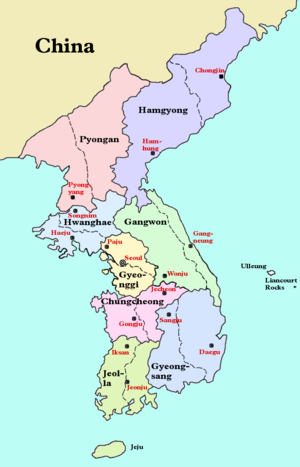مقاطعات كوريا الثمانية
(تم التحويل من Eight Provinces of Korea)
| المقاطعات الثمانية | |
| هانگول | 팔도 |
|---|---|
| هانچا | 八道 |
| الرومنة المعدلة | Paldo |
| مكيون-رايشاور | P'alto |
في معظم سنوات أسرة جوسون، كانت كوريا مقسمة إلى ثمان مقاطعات (do; 도؛ 道). ظلت حدود المقاطعات الثمانية كما هي لما يقارب 480 سنة من 1413 حتى 1895، وشكلت نموذجاً جغرافياً لا يزال أثره منعكساً حتى اليوم في التقسيمات الدارية لشبه الجزيرة الكورية، لهجاتها، وتميزها الاقليمي. أسماء المقاطعات الثمانية لا يزال محفوظاً حتى اليوم، بشكل أو بآخر. المقاطعات التاريخية الثمانية هذه تشكل كلاً من كوريا الشمالية والجنوبية، ويجب عدم الخلط بينها وبين المقاطعات الثمانية الحالية التي تشكل كوريا الجنوبية.
التاريخ
المقاطعات قبل 1895
مناطق 1895-96
عودة المقاطعات 1896
الأثر الثقافي
الاستخدام المعاصر
الأسماء
قائمة المقاطعات
| المقاطعة | هانگول | هانجا | أصل الاسم | العاصمة | الاسم الاقليمي | اللجهة | المقاطعات قبل-1896 | تقسيمات المقاطعات الحالية |
|---|---|---|---|---|---|---|---|---|
| تشنگتشونگ | 충청도 | [忠淸道] Error: {{Lang}}: script: kore not supported for code: ko (help) | Chungju + Cheongju | كونگجو | هوسيو (1) | لهجة تشنگتشونگ | ||
| گانگوون | 강원도 | [江原道] Error: {{Lang}}: script: kore not supported for code: ko (help) | Gangneung + Wonju | وونجو | گواندونگ (يونگسيو، يونگسيو (2)) |
لهجة گانگوون |
| |
| گيونگي | 경기도 | [京畿道] Error: {{Lang}}: script: kore not supported for code: ko (help) | (3) | هانسيونگ (سول) |
گيجيون (3) | لهجة سول |
| |
| گيونگسانگ | 경상도 | [慶尙道] Error: {{Lang}}: script: kore not supported for code: ko (help) | Gyeongju + Sangju | دايگو | يوناگنام | لهجة گيونگسانگ | ||
| هامگيونگ | 함경도 | [咸鏡道] Error: {{Lang}}: script: kore not supported for code: ko (help) | Hamhŭng + Kyŏngsŏng | هامهونگ | كوانبوك، كواننام (4) | لهجة هامگيونگ | ||
| هوانگهاي | 황해도 | [黃海道] Error: {{Lang}}: script: kore not supported for code: ko (help) | Hwangju + Haeju | هايجو | هايسو | لهجة هوانگهاي |
| |
| جيولا | 전라도 | [全羅道] Error: {{Lang}}: script: kore not supported for code: ko (help) | Jeonju + Naju (6) | جيونزو | هونام | لهجة جيولا؛ لهجة جيجو (7) |
||
| پيونگان | 평안도 | [平安道] Error: {{Lang}}: script: kore not supported for code: ko (help) | P'yŏngyang + Anju | پيونگيانگ | كوانسو | لهجة پيونگان |
انظر أيضاً
- قائمة موضوعات كوريا
- اللهجات الكورية
- مناطق كوريا
- مقاطعات كوريا
- المدن الخاصة في كوريا الشمالية
- المدن الخاصة في كوريا الجنوبية
- التقسيمات الادارية لكوريا الجنوبية
- التقسيمات الادارية لكوريا الشمالية
الهوامش
1. Pronounced "Ho-suh," not "Ho-zay-oh," as the spelling might suggest.
2. "Gwandong" is the name for the region as a whole, with "Yeongseo" denoting the western half of the province and "Yeongdong" the eastern half. "Yeongdong" is used more often than either of the other two terms, however, especially in reference to railway and road arteries that cross through Gangwon, connecting the Seoul and Yeongdong regions.
3. The province's name literally means "area within a 500-li (200-km) radius" (gi; 畿) of the "capital" (Gyeong; 京), referring to the royal capital Hanseong (modern-day Seoul). The regional name "Gijeon" is obsolete. The 20th-century term "Sudogwon" ("Capital Region") is used today to denote the Seoul-Incheon conurbation and that part of Gyeonggi Province that forms part of the same built-up, urban area.
4. "Kwanbuk" was used to designate either the province as whole, or only the northern part thereof. In the latter case, "Kwannam" was then used to denote the southern part of the province.
6. The initial "n" in "Naju" is pronounced as "l" (lower-case "L") when it comes after another consonant; the final "n" in the "Jeon" of "Jeonju" is then assimilated to an "l" sound.
7. The distinctive Jeju Dialect is used on Jeju Island, which became a separate province in 1946.
وصلات خارجية
- (كورية) South Korean government page on Korea's traditional provincial and regional names
- (كورية) Article on the eight provinces, and the 23 districts and 13 provinces that replaced them
- (كورية) Article on the 1895 changes to administrative divisions (includes a table listing the 13 post-1896 provinces)
- (كورية) Seoul City history article on Hanseong and 22 other late 19th-century districts (includes a detailed list of all the counties into which the 23 districts were divided)
الكلمات الدالة:
